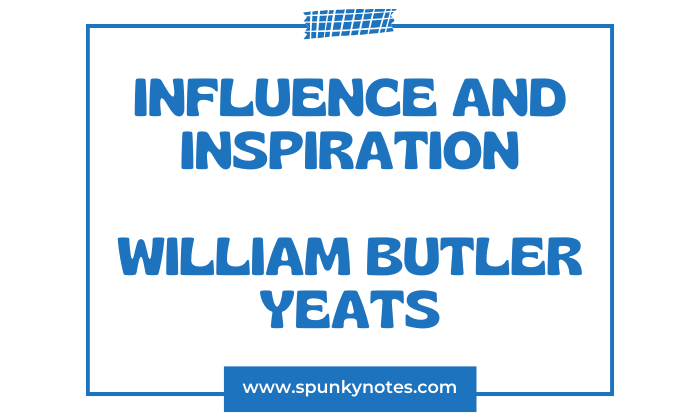
Q. A writer influences and gets influenced by the literary artists of his age. Discuss the statement with reference to the W B Yeats.
Introduction
W.B. Yeats, a prominent figure in 20th-century literature, was significantly influenced by the literary artists of his era and, in turn, influenced them.
His works reflect this ongoing interaction with his contemporaries and predecessors, shaping and reflecting the literary trends of his time.
Influence of Yeats’ Contemporaries
W.B. Yeats’s early work was heavily influenced by the aesthetic movement, which emphasized beauty and art for art’s sake, mirroring the values of contemporaries like Oscar Wilde.
This movement shaped Yeats’s initial focus on mysticism and aesthetic beauty in his poetry, as seen in his collection The Rose, which captures the ethereal and mystical qualities admired by the aesthetes.
As he matured, Yeats became increasingly involved with the Irish Literary Revival, a movement that sought to promote Irish culture and literature.
Through this engagement, he collaborated with other Irish writers, such as Lady Gregory and J.M. Synge, who influenced his shift towards incorporating Irish mythology and folklore.
This period marked a significant change in his writing, as seen in his later poems and plays, which drew heavily on Irish identity and history. Works like The Tower and The Winding Stair reflect this deep engagement with Irish heritage.
Moreover, his role in founding the Abbey Theatre with Lady Gregory provided a venue for Irish playwrights and poets, further emphasizing his commitment to Irish literary and cultural nationalism.
Through these interactions and collaborations, Yeats not only refined his artistic voice but also contributed to the broader project of defining Irish literature in the early 20th century.
His collaborations and their impact on his work are well-documented in his letters and biographical studies, such as those by R.F. Foster, which provide detailed accounts of his literary partnerships and their influence on his creative output.
Yeats’ Influence on Others
The following writers were significantly influenced by W.B. Yeats, each drawing from his thematic and stylistic elements in their diverse literary creations. Here are some notable examples:
James Joyce
Though often focusing on modernist themes and styles, James Joyce was influenced by Yeats’s commitment to Irish culture. This influence is evident in how Joyce incorporates Irish identity, folklore, and history into his works, such as “Ulysses,” which reflects complex layers of Irish cultural context.
T.S. Eliot
T.S. Eliot greatly respected Yeats’s work, particularly admiring his ability to remain relevant with age and use traditional poetic forms to address contemporary issues.
Eliot’s poetic form and thematic development show signs of Yeats’s influence, especially in how Eliot handles historical and cultural themes in poems like “The Waste Land.”
Ezra Pound
Ezra Pound and Yeats shared a close relationship, with Pound having worked as Yeats’s secretary for a time. Pound’s early poetic style influences Yeats, particularly in the rich symbolic imagery and the attention to cultural and historical detail. However, Pound later moved towards a more concise modernist style.
Sylvia Plath
Sylvia Plath drew inspiration from Yeats’s use of personal anguish and spiritual themes. Her poems, such as those in the collection “Ariel,” reflect a similar depth of emotional and psychological engagement. They mirror Yeats’ introspective and often somber poetic tone.
Allen Ginsberg
Allen Ginsberg was influenced by Yeats’s visionary qualities and spiritual examination. Ginsberg’s work in the Beat movement, including poems like “Howl,” echoes Yeats’s profound societal and spiritual observations, using poetry to challenge and reflect cultural norms.
Seamus Heaney
Seamus Heaney, a later Irish Nobel laureate, often cited Yeats as a primary influence. Heaney’s poetry is known for its rich use of Irish historical and mythological themes.
His collection, such as “North,” shows a clear lineage from Yeats. It reflects a deep engagement with the Irish landscape and psyche.
Samuel Beckett
Yeats influenced Samuel Beckett, an Irish playwright who participated in the modernist literary movement. Yeats’s skill with language and strong connection to Irish culture and history inspired Beckett.
Beckett became a key figure in the Theatre of the Absurd. An example of Yeats’s influence is seen in Beckett’s early poetry, especially in his collection ‘Echo’s Bones.’
In this collection, Beckett uses repetition and fragmentation to introduce ambiguity and uncertainty. This style mirrors Yeats’s use of symbolic language and his interest in mysticism.
Beckett’s most well-known play, Waiting for Godot, shares thematic similarities with Yeats’s plays The Cat and the Moon and The Land of Heart’s Desire.
Both Yeats and Beckett explore themes of identity, desire, and the search for meaning in a world full of uncertainty, often using mythological elements to deepen their stories.
Literary Techniques and Innovations
W.B. Yeats was renowned for his evolving literary techniques, which significantly impacted modern poetry. In his early years, Yeats often employed traditional poetic forms, drawing on romantic and mystical themes.
However, as his career progressed, he began experimenting with more modern approaches, influencing the transition towards modernist poetry.
One of Yeats’s notable innovations was his use of symbolism, which allowed him to convey deep personal and cultural themes in a dense, layered manner. This technique is evident in works like “The Second Coming,” where symbols reflect existential anxieties.
Yeats also pioneered the use of a more personal and direct poetic voice. He moved away from the ornate language of his early works. This shift is particularly apparent in his later poems, where he adopts a straightforward, conversational tone.
Yeats’s interest in the occult and Irish folklore also brought unique themes and imagery to his poetry. This characteristic sets him apart from his contemporaries.
Through these techniques and innovations, Yeats not only shaped his literary output but also influenced 20th-century literature,
Personal Relationships
Yeats’s relationships with other writers were both professional and deeply personal, further influencing his literary output. His tumultuous relationship with Maud Gonne, a fiery Irish nationalist, for instance, inspired some of his most passionate poems.
Similarly, his friendships with other writers allowed fruitful collaborations that influenced his work. His long friendship with Ezra Pound, an unofficial editor for some of Yeats’s work, exemplifies how personal relationships can shape literary output.
Conclusion
W.B. Yeats’s literary career was marked by the constant exchange of ideas and techniques with other writers of his time. He was both a product and a shaper of the literary landscape, absorbing influences from his contemporaries and predecessors while also setting new directions for others to follow.
His work reflects the literary environment of the early 20th century, demonstrating how a writer is both influenced by and an influencer of the literary artists of their age.

